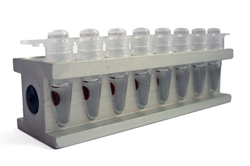How to properly cite our product/service in your work We strongly recommend using this: hMeDIP kit x16 (monoclonal mouse antibody) (Hologic Diagenode Cat# C02010031). Click here to copy to clipboard. Using our products or services in your publication? Let us know! |
Epigenetic modifier alpha-ketoglutarate modulates aberrant gene bodymethylation and hydroxymethylation marks in diabetic heart.
Dhat R. et al.
BACKGROUND: Diabetic cardiomyopathy (DCM) is a leading cause of death in diabetic patients. Hyperglycemic myocardial microenvironment significantly alters chromatin architecture and the transcriptome, resulting in aberrant activation of signaling pathways in a diabetic heart. Epigenetic marks play vital roles in tra... |
Methylation and expression of glucocorticoid receptor exon-1 variants andFKBP5 in teenage suicide-completers.
Rizavi H. et al.
A dysregulated hypothalamic-pituitary-adrenal (HPA) axis has repeatedly been demonstrated to play a fundamental role in psychiatric disorders and suicide, yet the mechanisms underlying this dysregulation are not clear. Decreased expression of the glucocorticoid receptor (GR) gene, which is also susceptible to epigen... |
Neonatal inflammation increases hippocampal KCC2 expression throughmethylation-mediated TGF-β1 downregulation leading to impairedhippocampal cognitive function and synaptic plasticity in adult mice.
Rong J. et al.
The mechanisms by which neonatal inflammation leads to cognitive deficits in adulthood remain poorly understood. Inhibitory GABAergic synaptic transmission plays a vital role in controlling learning, memory and synaptic plasticity. Since early-life inflammation has been reported to adversely affect the GABAergic syn... |
The age of bone marrow dictates the clonality of smooth muscle-derivedcells in atherosclerotic plaques.
Kabir I. et al.
Aging is the predominant risk factor for atherosclerosis, the leading cause of death. Rare smooth muscle cell (SMC) progenitors clonally expand giving rise to up to ~70\% of atherosclerotic plaque cells; however, the effect of age on SMC clonality is not known. Our results indicate that aged bone marrow (BM)-derived... |
Spurious transcription causing innate immune responses is prevented by5-hydroxymethylcytosine.
Wu F. et al.
Generation of functional transcripts requires transcriptional initiation at regular start sites, avoiding production of aberrant and potentially hazardous aberrant RNAs. The mechanisms maintaining transcriptional fidelity and the impact of spurious transcripts on cellular physiology and organ function have not been ... |
Developmental and Injury-induced Changes in DNA Methylation inRegenerative versus Non-regenerative Regions of the VertebrateCentral Nervous System
Reverdatto S. et al.
Background Because some of its CNS neurons (e.g., retinal ganglion cells after optic nerve crush (ONC)) regenerate axons throughout life, whereas others (e.g., hindbrain neurons after spinal cord injury (SCI)) lose this capacity as tadpoles metamorphose into frogs, the South African claw-toed frog, Xenopus laevis, o... |
Bone marrow age dictates clonality of smooth muscle-derived cells in theatherosclerotic plaque
Kabir Inamul et al.
Aging is the predominant risk factor for atherosclerosis, the leading cause of death. Rare smooth muscle cells (SMCs) clonally expand giving rise to up to ∼70\% of atherosclerotic plaque cells; however, the effect of age on SMC clonality is not known. Our results indicate that aging induces SMC polyclonality and... |
Epigenetic remodelling of enhancers in response to estrogen deprivationand re-stimulation.
Sklias Athena et al.
Estrogen hormones are implicated in a majority of breast cancers and estrogen receptor alpha (ER), the main nuclear factor mediating estrogen signaling, orchestrates a complex molecular circuitry that is not yet fully elucidated. Here, we investigated genome-wide DNA methylation, histone acetylation and transcriptio... |
Transcription of synaptic plasticity-related genes in patients with somnipathy combined with type 2 diabetes
Yi Zhang, Rui Ma, Shaohong Zou, Gaiyu Tong, Gulibakeranmu Abula, Manna Hu, Qing Dai
Objective: To investigate DNA methylation and hydroxymethylation in patients with somnipathy combined with type 2 diabetes, and to explore the effects of DNA methylation and hydroxymethylation on gene expression.
Methods: Thirty patients with somnipathy combined with type 2 diabetes and 20 patients with type-2 diab... |
Emerging Role of One-Carbon Metabolism and DNA Methylation Enrichment on δ-Containing GABAA Receptor Expression in the Cerebellum of Subjects with Alcohol Use Disorders (AUD
Gatta E. et al.
Background
Cerebellum is an area of the brain particularly sensitive to the effects of acute and chronic alcohol consumption. Alcohol exposure decreases cerebellar Purkinje cell output by increasing GABA release from Golgi cells onto extrasynaptic α6/δ-containing GABAA receptors located on glutamate... |
Coordinate Regulation of TET2 and EBNA2 Control DNA Methylation State of Latent Epstein-Barr Virus
Lu F. et al.
Epstein-Barr Virus (EBV) latency and its associated carcinogenesis are regulated by dynamic changes in DNA methylation of both virus and host genomes. We show here that the Ten-Eleven Translocation 2 (TET2) gene, implicated in hydroxymethylation and active DNA demethylation, is a key regulator of EBV latency type DN... |
Decoupling of DNA methylation and activity of intergenic LINE-1 promoters in colorectal cancer
Vafadar-Isfahani N. et al.
Hypomethylation of LINE-1 repeats in cancer has been proposed as the main mechanism behind their activation; this assumption, however, was based on findings from early studies that were biased toward young and transpositionally active elements. Here, we investigate the relationship between methylation of 2 intergeni... |
Maternal immune activation induces GAD1 and GAD2 promoter remodeling in the offspring prefrontal cortex
Labouesse MA et al.
Maternal infection during pregnancy increases the risk of neurodevelopmental disorders in the offspring. In addition to its influence on other neuronal systems, this early-life environmental adversity has been shown to negatively affect cortical γ-aminobutyric acid (GABA) functions in adult life, including imp... |
Hepatic DNA hydroxymethylation is site-specifically altered by chronic alcohol consumption and aging
Tammen SA et al.
PURPOSE:
Global DNA hydroxymethylation is markedly decreased in human cancers, including hepatocellular carcinoma, which is associated with chronic alcohol consumption and aging. Because gene-specific changes in hydroxymethylcytosine may affect gene transcription, giving rise to a carcinogenic environment, we det... |



